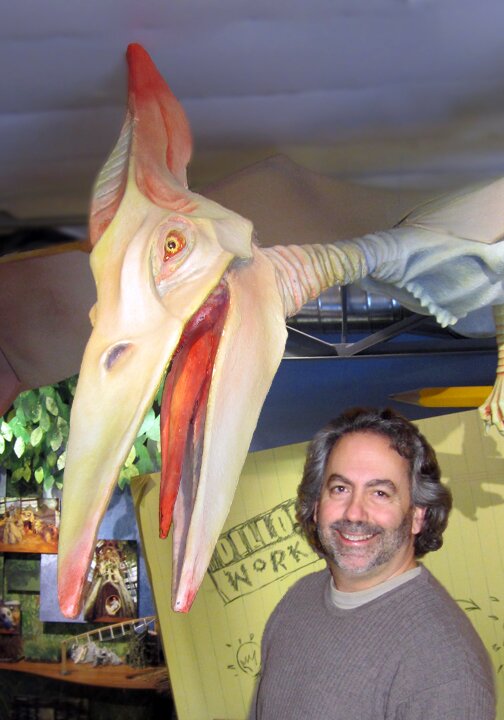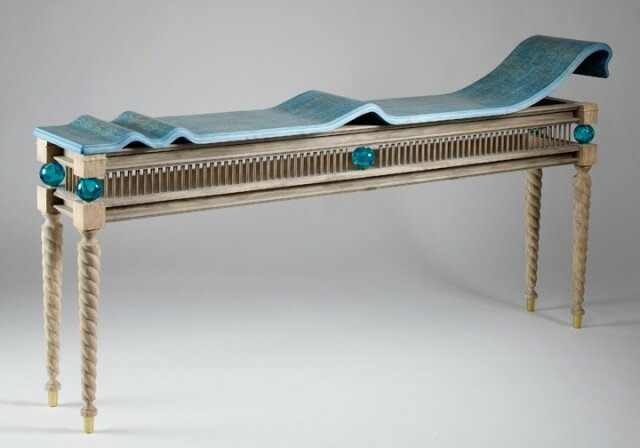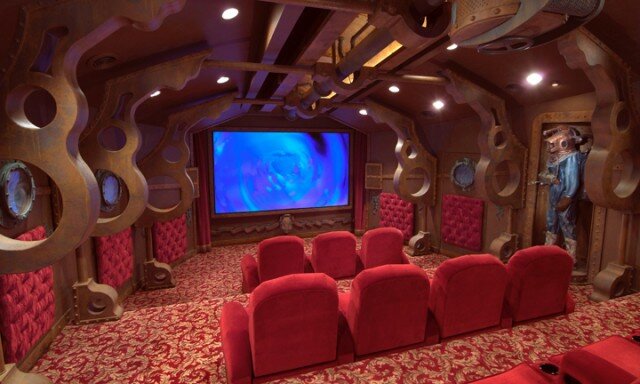Months ago I took a trip to Mukilteo, to the headquarters of Dillon Works, which you can spot by the large paper airplane crashed on its roof–and by large, I mean, about 20 feet long. Overhead at reception flies a pterodactyl. In a conference room, there is a bear, standing upright and holding a picture frame, and if you pull on the picture frame’s right edge, it opens to reveal a mini fridge.
The “design and fabrication of almost anything” is the company’s motto, and it’s startling as you leaf through a portfolio of past works, how often your eyes are fooled by something sculpted from styrofoam or cut from metal. Locally, you can take a trip to the Woodland Park Zoo’s Zoomazium to take in more Dillon Works’ trompe l’oeil-ery. Realism is not always the goal, however; their 50-foot tall exterior façade for the “Tooner Field” (at Atlanta’s Turner Field) is authentic to the Cartoon Network’s aesthetic.
Mike Dillon, president of Dillon Works, exhibits both the drive of the entrepreneur and the joy of a kid showing off an overflowing toy chest, as he shows visitors around, from CAD-savvy designers’ offices where everyone’s gathered around computer monitors, to the room where a laser cuts three-dimensional shapes from various materials, to the paint studio where teams of artists add finishes and patterns. There’s a blend of high- and low-tech on display–on one wall hang an assortment of curry combs made for horses but which turn out to be great for sculpting foam.
Dillon Works employs a floating number of artisans, usually about 60 staff and freelancers, depending upon the number of projects they’re working on. Some, like “Tooner Field,” are large commercial projects–Dillon got his start as an “imagineer” for Walt Disney Imagineering. Some, like the Nautilus home theater, are the fulfillment of a wealthy person’s whimsy. But you can find Dillon Works magic in a lot of other places, too, that you might not expect. Those resin buckles on Donna Karan clothing, evoking glass artist William Morris? Glass was too heavy, so Dillon Works provided the look without the heft.
Dillon’s latest enterprise is an offshoot he calls Alchemy Bluff Studios, a “diversion” of Dillon Works. Its product line includes, besides one-of-a-kind items made to order, furniture like a birch bookshelf that combines alder with a birch veneer, and resin trim cast from a real birch branch. At first glance, you simply note how marvelous it is that the “branches” fit the shelf so well; later, you keep touching it to verify that it’s not wood, since your eye insists that it is.
This is a different kind of “virtualization,” and once your eyes have been opened to it (so to speak) you start to see it everywhere. Especially in industrial decor, things that you might have thought were built in place reveal themselves to be fully sculpted, perhaps with a metal skeleton. That’s the point, often–that neo-’50s fast food icon wants you to think it’s solid, shiny plastic. But it goes further–sometimes that exposed girder isn’t one, it just suited the design aesthetic. It’s a fascinating experience to walk through modern construction and guess at what’s “real” and what’s not, but it’s also an experience that poses a question: Does it matter, if what you were after from the real thing was in fact the look of it?














